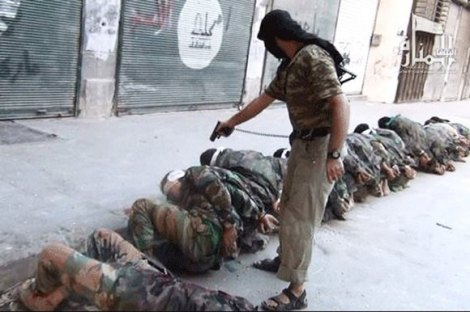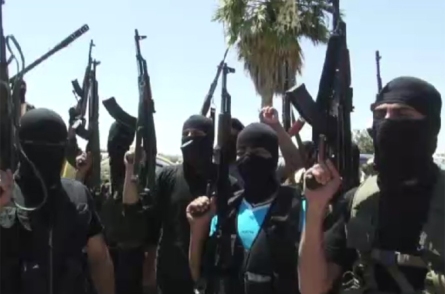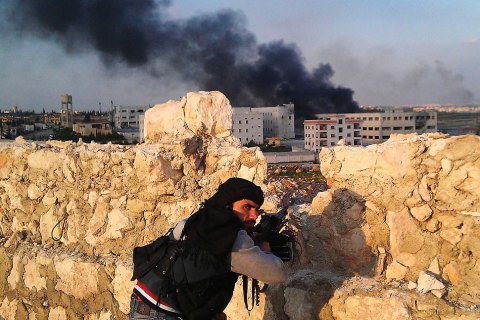Recently tensions have been mounting between self-declared jihadists and Western-backed moderates fighting the Bashar al-Assad government in Syria. But who are these self-declared jihadists and how influential are they? How many factions or sub-groups make up the armed opposition? This article attempts to explain how complex the armed opposition in Syria really is.
When I began researching into the opposition my head began to spin. I found countless organizations and quickly realized how complex the situation really is. Tensions and hostilities are bound to arise when contrasting groups are trying to unite and fight together.
The main opposition group fighting in Syria is the Free Syrian Army (FSA) having an estimated 80,000 to 100,000 fighters. Composed of defected Syrian armed forces personnel and volunteers it is the most secular and moderate part of the opposition and has no political goals except the removal of the Bashar al-Assad government. Most FSA members are Sunni; the largest branch of Islam and Syria’s largest community.
The FSA mostly operate in the central region of Syria, Homs, Hama and the surrounding areas, but have elements operating nationwide. It has adopted guerrilla-style tactics against the government having declared it does not have the resources to occupy and take control of territories. It has very few heavy weapons and makes use of improvised explosive devices to attack military convoys of buses, trucks and tanks that are transporting supplies and security personnel.
Rebel fighter summarily executing prisoners
The FSA is internationally supported and are seen as the ‘good guys’. Sadly, a little research and you find out that the good guys are not so good. They have been accused of summarily executing prisoners, recruiting children as soldiers, kidnapping and executing pilgrims and a prominent Syrian actor, throwing civilians off rooftops and cutting organs from the bodies of dead prisoners.
Another group operating in Syria is the al-Nusra Front (ANF) or Jabhat al-Nusra. The ANF is an al-Qaeda associate and is designated a terrorist organization by the United Nations, the United States, Australia, and the United Kingdom. They have been described as “the most aggressive and successful arm of the rebel force” and as of early 2013, the ANF is estimated to have around 6,000 fighters. The ANF desires to create a Syria under Sharia law which alarms the more secular armed groups.
The FSA has consistently condemned the ANF´s use of suicide bombs during the war and indeed it appears that suicide bombings are their expertise. As of June 2013, the ANF had claimed responsibility for 57 of the 70 suicide attacks carried out since the beginning of the war.
al-Nusra Front Fighters
Strong words have been exchanged between the FSA and ANF for some time. The FSA accuses the ANF and others of “hijacking a revolution that began as an uprising to demand a democratic system”. According to the FSA their presence is reducing popular support for the opposition and many want the ANF to leave Syria. In December 2012 a leading FSA fighter made clear the way future events may unfold. “The next war after Bashar al-Assad falls will be between us and the Islamists”.
One group which probably has broader support among ordinary Syrians is the Syrian Islamic Front (SIF), with an estimated 25,000 fighters. The SIF declares its aims as toppling the Assad government and establishing an Islamic state. It opposes U.S. intervention against the regime and would consider such an intervention as new aggression against Muslims. Its largest group is the Salafist Ahrar al-Sham, which reportedly leads and dominates the Front.
As of late 2012, one of the strongest armed coalitions in Syria, representing up to half of Bashar al-Assad’s armed opponents, was the Syrian Islamic Liberation Front (SILF) estimated at having up to 40,000 fighters. The SILF overshadows the FSA in some regions and has some of the most important rebel units active in the war. The coalition obtains their weapons from attacks on the Syrian armed forces and from arms dealers but is also reportedly receives support from Turkey and Qatar. Again, the SILF much like the FSA has a minimalist political platform, promising to protect minorities and stating that religious Muslim law is the point of reference for the group.
Another group fighting in Syria is the Syrian Liberation Army (SLA); a loose coalition of localized forces, mostly composed of armed Syrian civilians who have joined the uprising. Based in Idlib Governorate, the SLA is primarily concerned with trying to expel government forces from the governorate. The SLA claims that over 70,000 youths are ready to join the group but are prevented from doing so due to lack of weaponry and equipment. Similarly to the FSA, the SLA concentrates on bombings and roadside explosions.
Having a little understanding of the groups involved helps understand recent developments.
Recently the al-Nusra Front (ANF) have said that they fear U.S. missile attacks against Syrian military installations would also target them, and that the West is seeking to use moderate rebel factions to keep them in check. In early September the ANF announced it would “go to war” against other rebel groups in in the Aleppo governorate.
Syrian Islamic Front fighter on the outskirt of Aleppo
Battles have taken place between rebel factions over the last few days.
On 14-September in the eastern province of Deir Ezzor, near the Iraqi border, deadly clashes erupted between the ANF and FSA.
On 18-September ANF fighters killed FSA members and took control of an area close to the Turkish border. Fighters from the Islamic State of Iraq and the Levant, an element of the ANF stormed the town of Azaz, 5km from the Syrian-Turkish border, and killed at least five FSA members, activists reported, adding 100 people were taken captive.
Allegations are also circulating that some rebel groups are collaborating with the Assad regime. The Ahfad al-Rasul Brigade, who operates independently, is such a group and has been accused of doing so by the ANF. Along with the allegation the ANF blew up the Ahfad al-Rasul headquarters and rounded up several of its members.
“You do not see ANF fighters in hotspots clashing with the regime. You see them trying to extend their control to areas we struggled hard to liberate” an Ahfad al-Rasoul fighter told Al Jazeera.
Recent developments have revealed major fractures are emerging within the armed opposition. Territorial disputes are taking place and threats are being made. The future of the struggle against the Bashar al-Assad government in Syria looks bleak.
Author: Martin Edwards
Originally posted on The Pianosa Chronicle




No comments:
Post a Comment